Class 11 Biology Chapter 13 Photosynthesis in Higher Plants, AHSEC Class 11 Biology Question Answer, HS 1st year Biology notes to each chapter are provided in the list so that you can easily browse throughout different chapters Assam Board Class 11 Biology Chapter 13 Photosynthesis in Higher Plants Question Answer and select needs one.
Class 11 Biology Chapter 13 Photosynthesis in Higher Plants
Also, you can read the SCERT book online in these sections Solutions by Expert Teachers as per SCERT (CBSE) Book guidelines. These solutions are part of SCERT All Subject Solutions. Here we have given Assam Board Class 11 Biology Chapter 13 Photosynthesis in Higher Plants Solutions for All Subjects, You can practice these here.
Photosynthesis in Higher Plants
Chapter – 13
VERY SHORT ANSWER TYPE QUESTIONS
Q.1. What type of process is photosynthesis?
Ans :- Photosynthesis is a physicochemical process.
Q.2. Why is photosynthesis important?
Ans :- Photosynthesis is important due to two reasons it is the primary source of all food on earth. It is responsible for the release of oxygen into the atmosphere by green plants.
Q.3. Who and when revealed the role of air in the growth of green plants?
Ans :- Joseph Priestly in 1770, revealed the role of air in the growth of green plants.
Q.4. Which plant was used by peristyle for his experiment?
Ans :-Mint plant was used by Priestley for his experiment.
Q.5. What did priestley hypothesized?
Ans :- Priestley hypothesised, “Plants restore to the air whatever breathing animals and burning candle remove.
Q.6. Who showed that sunlight is essential to the plant?
Ans :- Jan lngenhousz (1730-1799) showed that sunlight is essential to the plant.
Q.7. What observation were made by Ingenuous when sunlight was supplied to the plant?
Ans :- Small bubbles were found around the green plant when placed in sunlight.
Q.8. What did Ingenhousz conclude?
Ans :- Ingenhousz concluded that only the green part of the plant could release oxygen.
Q.9. Write the empirical equation representing photosynthesis.
Ans :-

Q.10. Write the overall process of photosynthesis.
Ans :-

Q.11. What are the structures present in the chloroplast?
Ans :- Within the chloroplast there is a membranous system consisting of grana, the stroma lamellae and the fluid stroma.
Q.12. What is the function of membrane system?
Ans :- The membrane system is responsible for trapping the light energy an also for the synthesis of ATP and NADPH.
Q.13. What are leaf pigments?
Ans :- Pigments are substances that have an ability to absorb light, at specific wavelength.
Q.14. What are the different pigments present in plant?
Ans :- The different pigments present in plant are chlorophyll a, chlorophyll b, xanthophyll and carotenoid.
Q.15. Which is the chief pigment present in plant?
Ans :- Chlorophyll a is the chief pigment present in plant.
Q.16. What are the accessory pigments of plants?
Ans :- Chlorophyll b, xanthophyll and carotenoid are accessory pigment of the plants.
Q.17. What is antennae?
Ans :- The photosystem has all the pigment forming a light harvesting system also called antennae.
Q.18. Why is photosystem I called P 700.
Ans :- In photosystem I, the reaction centre, chlorophyll a has an absorption peak at 700 nm, hence it is called P700.
Q.19. Why is photosystem II called P680.
Ans :- In photosystem II, the reaction centre chlorophyll a has an absorption peak at 680 nm, hence it is called P680.
Q.20. With which photosystem is the splitting of water associated?
Ans :- The splitting of water is associated with photosystem II.
Q.21. What is phosphorylation?
Ans :- The process by which ATP is synthesised by the cells (in mitochondria and chloroplast) is called phosphorylation.
Q.22. Why is the proton gradient important?
Ans :- The proton gradient is important because it is the breakdown of this gradient that leads to the release of energy.
Q.23. What are the parts of ATP ase enzyme?
Ans :- The ATP ase enzyme consists of two parts F₀ and F₁.
Q.24. What are the end-products of light reaction?
Ans :- The end product of light reaction are ATP, NADPH and O₂.
Q.25. Mention the first product of Calvin Cycle?
Ans :- 3- phosphoglyceric acid is the first product of calvin cycle.
Q.26. Which compound is the primary acceptor of co₂?
Ans :- Ribulose biphosphate (RuBP).
Q.27. Which compound is the primary accepter of Co₂ in C₄ cycle?
Ans :- In C₄ cycle, the primary acceptor of Co₂ is phosphoenol pyruvic acid (PEP).
Q.28. What does the word ‘kranz’ mean in ‘kranz’ anatomy’?
Ans :- Kranz means ‘wreath’ and is a reflection of the arrangement of cells.
Q.29. Which enzyme is responsible for PEP fixation?
Ans :- PEP carboxylase.
Q.30. Define photorespiration.
Ans :- The respiration that occurs in green plants in the presence of light is called photorespiration.
SHORT ANSWER TYPE QUESTIONS
Q.1. What is a half leaf experiment?
Ans :- In half leaf experiment, a part of the leaf is enclosed in a test tube containing some soaked cotton (which absorb Co₂) while the other half exposed to air. The set up is then placed in light for sometime. On testing it was found that the exposed part of the leaf tested positive for starch while the portion in the tube, tested negative.This showed that Co₂ is required for photosynthesis.
Q.2. What were the observation of Julius von Sachs?
Ans :- Julius von Sachs provided evidence for the production of glucose when plant grow. Glucose is stored as starch. He showed that the green substances in plants are located in special bodies (which were later called chloroplast) within plant cells.
Q.3. What was the contribution of van Niel?
Ans :- Van Niel, who based on his studies of purple and green bacteria, demonstrated that photosynthesis is essentially a light depended reaction in which hydrogen from a suitable oxidizable compound reduces carbon- dioxide to carbohydrate.

Q.4. Oxygen evolved by green plants comes from water (H₂O), not form carbon- dioxide comment.
Ans :- In green plants H₂O is the hydrogen donor and is oxidised to 0₂. Some organism do not release 0₂ during photosynthesis. When H₂S, instead is the hydrogen donor for purple and green sulphur bacteria, the oxidation product is sulphur or sulphate depending on the organism and not 0₂. Hence, oxygen evolved by green plants comes form H₂O and not Co₂.

Q.5. Structurally describe the chloroplast?
Ans :- Chloroplast is that structure in the leaf where photosynthesis occur. It is bounded by double membranes. Internally, the chloroplast shows two distinct region – stroma and grana. Stroma is the site of dark reaction of photosynthesis. The granum is the site of light reaction.

Q.6. What do you mean by absorption spectrum and action spectrum?
Ans :- The visible spectrum in which photosynthesis occurs lies between 390-760 mn. The rate of absorption of light by different pigment is measured by spectrophotometer. A spectrophotometer can measure the rate of absorption of light of particular wavelength by the pigments in the solution. A curve obtained by plotting the amount of absorption of different wavelength of light by a particular pigment is called absorption spectrum. Chlorophyll a absorbs maximum in blue and red region of the spectrum.
The effectiveness of different wavelength of light on photosynthesis is measured by the rate of Co₂ fixation, O₂ evolution, NADP reduction. The action of different wavelength of light on photo synthesis is called action spectrum.
Q.7. What are the important step in electron transport system?
Ans :- In photosystem II, the reaction centre chlorophyll a absorbs 680 nm wavelength of red light causing electron to become excited and jump into an orbit. These electron are picked up by an electron acceptor which passes them to electron transport system. This movement of electron is downhill. The electrons are passed on the pigments of photo system I (PSI). The electrons in the reaction centre of PSI are also excited when thy receive red light of wavelength 700 nm and are transferred to another acceptor molecule. These electrons then are moved downhill again and reduces NADP to NADPH₂. This whole scheme of transfer of electron starting from PSII, uphill to the acceptor, down the electron transport chain to PSI and finally down to NADP+ reducing it to NADPH₂ is called Z-scheme.
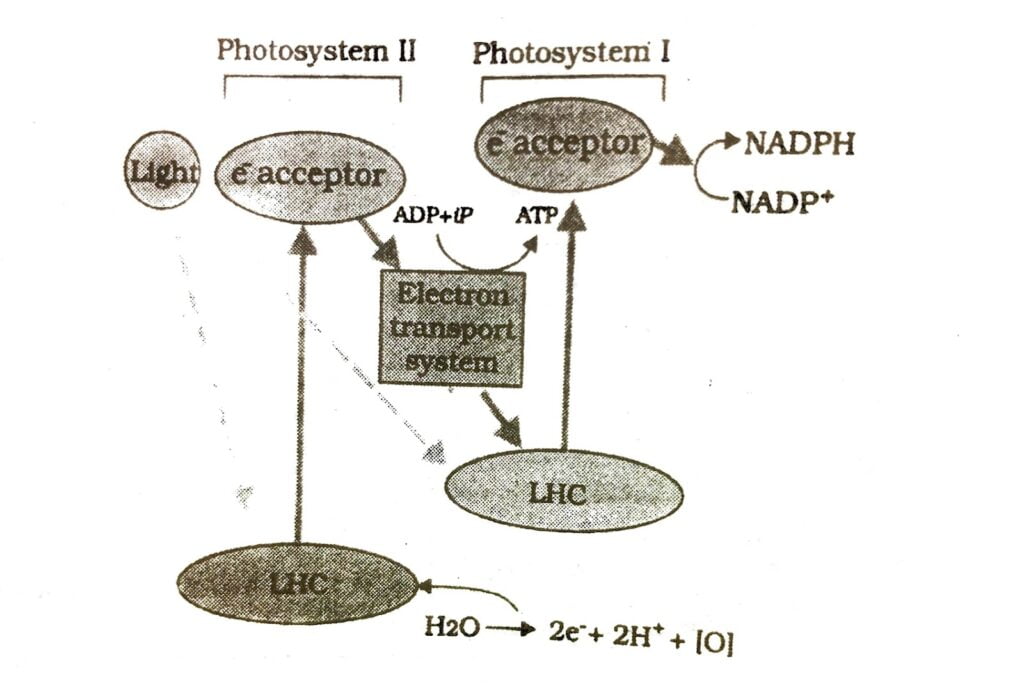
Q.8. Who proposed the five kingdom concept of classification? Mention the criteria for separating diverse organism in this five kingdom concept?
Ans :- Robert H. Wittaker (1969), an American taxonomist proposed the concept of five kingdom are –
i) The complexity of cell structure: For example – Prokaryote and Eukaryotes are included in different groups.
ii) The complexity of body of organism: For example- Prokaryote and Eukaryotes organism are included in different groups.
iii) The mode of obtaining nutrition.
Q.9. What is photolysis of water?
Ans :- It is a process in which water molecule is broken into hydrogen and oxygen with the help of photon energy entrapped by chlorophyll pigment.
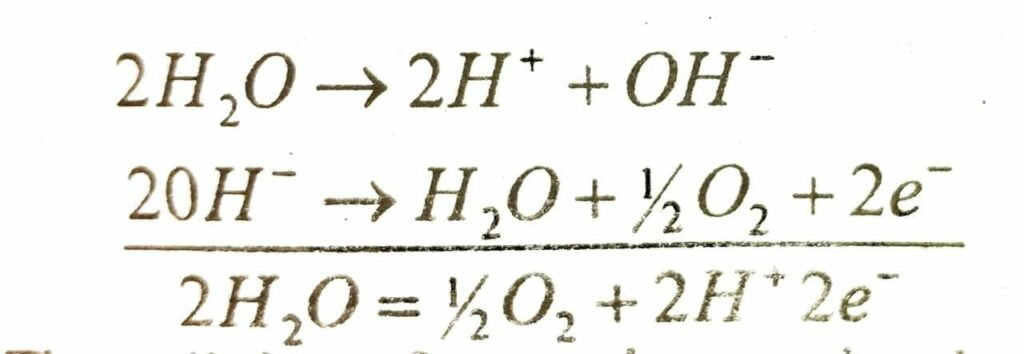
The splitting of water is associated with PSII, water is split into H⁺, [O] and elections. This creates oxygen, one of the net product of photosynthesis. The elections needed to replace those removed from photosystem I are provided by photosystem II.
Q.10. Explain chemiosmotic hypothesis.
Ans :- The chemiosmotic hypothesis explains the mechanism of ATP synthesis. Chemosmosis required a membrane, a proton pump, a proton gradient and AT pase. Energy is used to pump proton across the membrane to create a gradient or a high concentration of protons within the thylakoid lumen. ATP ase has a channel that allows the diffusion of proton back across the membrane, this releases enough energy to activate AT Pase enzyme that catalyses the formation of ATP.
Q.11. What is carboxylation in Calvin cycle?
Ans :- Carboxylation is the fixation of Co₂ into a stable organic intermediate. It is the most crucial step of calvin cycle where Co₂ is utilised for the carboxylation of RUBP. This reaction is catalysed by enzyme RUBP. Carboxylase which results in the formation of two molecules of 3 PGA. Since RUBP carboxylase also has an oxygenation activity, it is more correctly called RUBP carboxylase oxygenase or RUB is Co.
Q.12. Why the enzyme RUBP carboxylase able to bind both CO₂ and O₂?
Ans :- RuBisCO has a much greater affinity for CO₂ than for O₂. It is the relative concentration of O₂ and Co₂ that determines which of the to will bind to the enzyme.
In C₃ plant, some O₂ binds to RuBisCo and hence Co₂ fixation is decreased. Here the RuBP instead of being converted to a molecules of PGA binds with O₂ to form one molecule of phosphoglycerate and phosphoglycerate in a pathway called photorespiration.
In C₄ plants, photorespiration does not occur. This is because they have a mechanism that increases the concentration of CO₂ at the enzyme site. This takes place when C₄ acid from the mesophyll is broken down to release CO₂ this results in increasing the CO₂ concentration. Hence RUB is CO function as carboxylase minimising the oxygenase activity.
Thus RuBP carboxylase is able to bind both CO₂ and 0₂.
Q.13. Distinguish between PS-I and PS-II.
Ans :- PS-I
i) The reaction centre is P700.
ii) It is located in the other surface of thylakoid.
iii) Involves both cyclic and non-cyclic phosphorylation.
iv) Receives electron from PS-II.
PS-II
i) The reaction centre is P680.
ii) It is located in the inner surface of the thylakoid.
iii) Involves only non-cyclic phosphorylation.
iv) Donate electron to PS-I.
Q.14. Differentiate between light and dark reaction.
Ans :- Light reaction: i)
Takes place in the presence of light.
ii) Takes place in the grana of chloroplast.
iii) Light energy is converted to chemical energy in the form of ATP and NADPH₂.
iv) No. Carbohydrate is forced.
Dark reaction: i)
Light is not essential.
ii) Takes place in stroma of chloroplast.
iii) ATP and NADPH₂ are utilised for CO₂ fixation.
iv) Carbohydrate in the form of starch is formed.
LONG ANSWER TYPE QUESTIONS
Q.1. Mention the adaptations of leaves for photosynthesis. Name and characterise the different chloroplast containing cells in the leaves. What in the site of light reaction during photosynthesis.
Ans :- Adaptations of leaves for photosynthesis.
(i) Leaves become broad and are arranged in such a way that they get maximum sunlight.
(ii) Stoma (sing-stomata) of leaves facilitate exchange of CO₂ and O₂ through diffusion.
(iii) The network of veins provide easy supply of water for photosynthesis.
(iv) To increase the efficiency of photosynthesis some leaves are provided with Kranz type to leaf anatomy.
Different chloroplast containing cells of the leaves are:
(a) Palisade parenchyma: These are elongated cells without any intercellular space.
(b) Spongy parenchyma: These are oval or globular in shape and are provided with large intercellular spaces.
The site of light reaction during photosynthesis is Thylakoids.
Q.2. (a) State four differences between C₃ and C₄ plants.
Ans :- C₃ plants: 1. Calvin cycle or C₃ cycle occurs in C₃ plants.
2. C₃ plants have only one type of chloroplast.
3. Do Not have Kranz anatomy.
4. Photorespiration occurs in such plants.
C₄ plants: 1. Hatch and Slack or C₄ Cycle occurs in C₄ plants.
2. Two types of chloroplasts are present in C₄ plants. The chloroplasts of the mesophyll cells are smaller and the chloroplasts of the bundle sheath cells are larger and lack grana.
3. Have Kranz anatomy.
4. Photorespiration does not occur in such plants.
Q.2. (b) Describe briefly the non-cyclic flow of electron in photosynthesis. How non cyclic flow differs from the cyclic one?
Or Define photophosphorylation. Describe briefly the non cyclic flow of electron in photosynthesis and how it differs from cyclic one.
Ans :- The formation of energy rich phosphate molecules i.e. ATP in presence of light is called photophosphorylation.
The non cyclic flow of electron involves the following steps:
(a) Excitation of chlorophyll molecule:
Non cycle flow of electron involves both PSI and PSII. The photocentre of P $ I is P700 and PSII in P680. When the pigments of PSII acquires sufficient photon of light, it emits an electron.
(b) Electron transport system:
The electron with potential energy moves down an electron transport chain consisting of an unknown compound i.e. primary acceptor, plastoquinone (PQ), Cytochrome complex (Cyt. Comp) and Plastocyanin (PC). During this process of electron transfer ATP is formed. The electron lost from PSII is ultimately accepted by PSI which transfer its electron to Ferredoxin (Fd). Ferredoxin in turn transfer the electron to NADP to generate NADPH₂ along with protons generated by splitting of water in PSII.
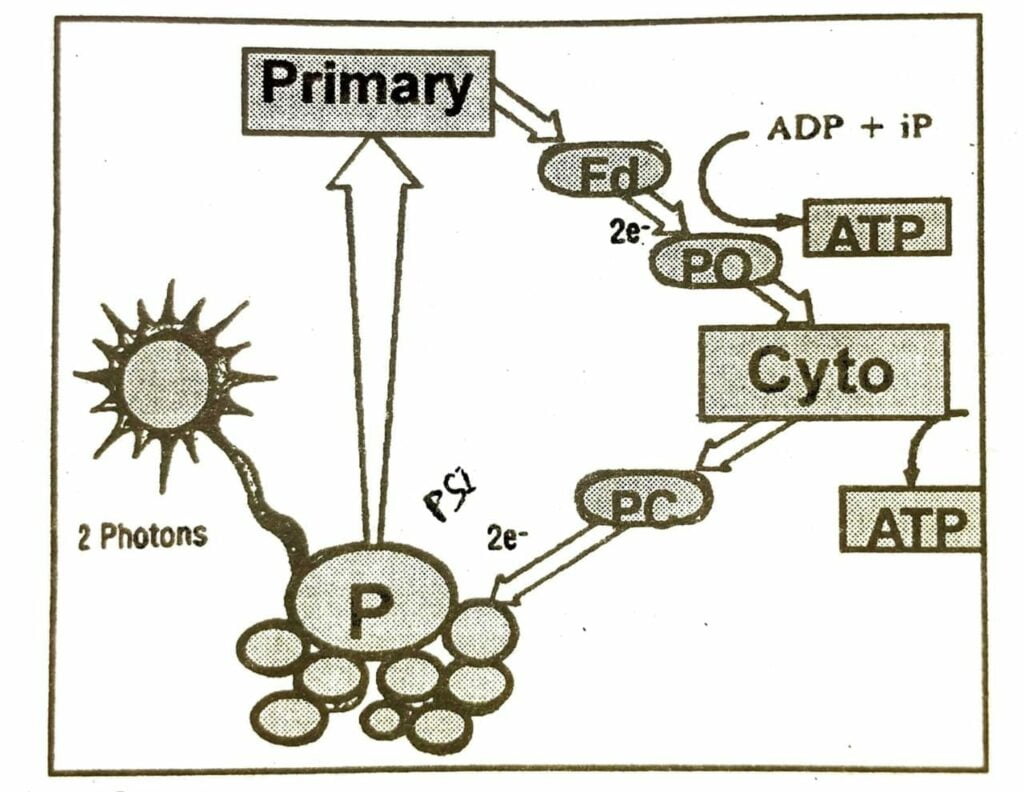
(c) Photolysis of water:
The splitting of water in presence of light to generate 2H⁺, 2e⁻ and O₂ is called photolysis of water . The electron hole created in PSII as a result of ejection of electron is filled up by electrons emitted during photolysis of water.
As the flow of electron is not cyclic i.e., the electrons emitted from PSII does not return back to PSII, the process in called non-cyclic photophosphorylation.
Cyclic Photophosphorylation: (i) Involves photo system I only.
(ii) The electron ejected from the chlorophylle returns to the same chlorophyll in cyclic manner.
(iii) Photolysis of water does not take place and O₂ is not evolved.
(iv) It synthesises ATP only.
Non-Cyclic Photophosphorylation: (i) Involves both photosystem I and II.
(ii) The electrons ejected from the chlorophyll never returns to the same chlorophyll.
(iii) Photolysis of water takes place, O₂ is evolved.
(iv) It synthesises both ATP and NADPH₂.
Q.3. Describe the process of cyclic photophosphorylation. Why this process is called a cyclic process.
Ans :- Diag: Schematic representation of Cyclic photophosphorylation.The process of cyclic
photophosphorylation can be described as follows:
(a) Excitation of chlorophyll molecules:
Cyclic photophosphorylation takes places in photocentre I whose reaction centre is P700. The the pigments of PSI absorbs a photon of light it get excited and emits an electron.
(b) Electron Transport system:
The electron with high potential energy enters an electron transport system consisting of an unknown compound primary acceptor, Ferredoxin, Plastoquinone (PQ), Cytochrome Complex (Cyto. Complex), Plastocyanin (PC) and ultimately returns back to PSI. During this electron transfer ATP is formed .
Since the electron emitted from PSI return back to PSI in cyclic manner and energy rich phosphate molecule i.e. ATP in formed under the influence of light, this process is called cyclic photophosphorylation.
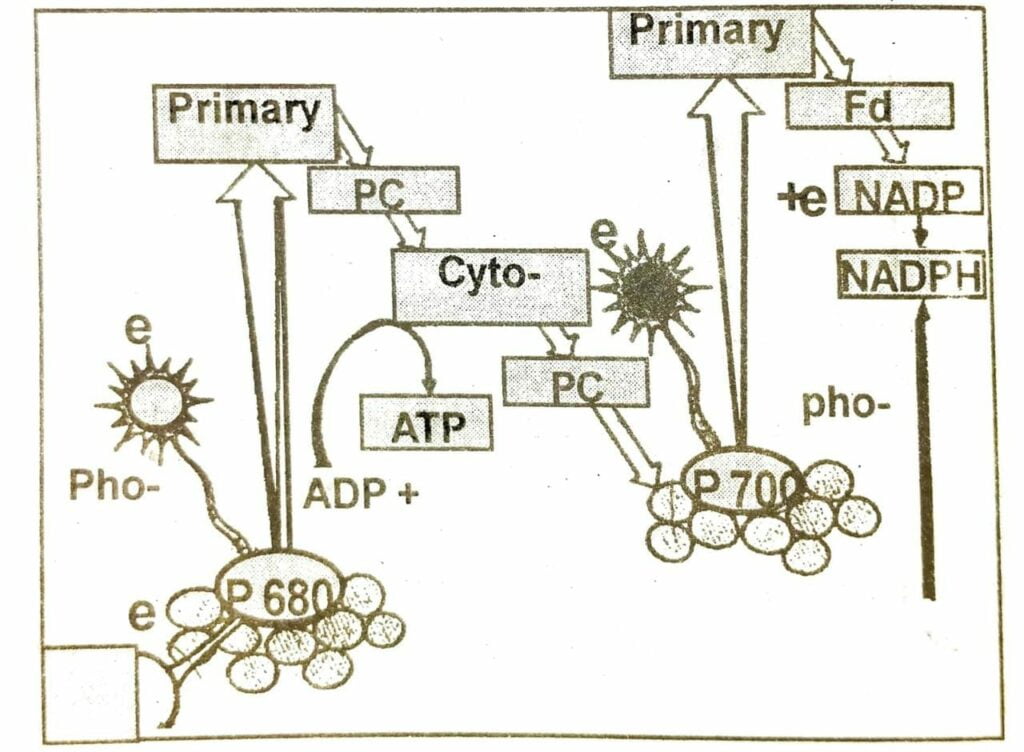
Q.4. Describe briefly the different steps in Calvin cycle. Mention at least four points of difference between Calvin Cycle and Hatch and Slack Cycle.
Ans :- The various steps involved in Calvin cycle are :-
(1) Carboxylation: Of six molecules In this step of Ribulose monophosphate (RuMP) is converted into 6 molecules of Ribulose 1, 5 diphosphate (RuDP). RuDP combines with CO2 to produce twelve (12) molecules of 3 phosphoglyceric acid (PGA).
6RuMP + 6ATP → 6 RuDP + 6ADP + 6ip
6 RuDP + 6Co 2 → (12) 3- PGA.
2. Glycolytic reversal: In this phase PGA is converted into. Phosphoglyceraldehyde. It occurs in two steps. In the first stage PGA in presence of ATP in converted into 1, 3 diphosphoglyceric acid (dPGA).
12 PGA + 12ATP → 12 dPGA + 12ADP + 12Pi
In the next step dPGA in reduced to phosphoglyceraldehyde (PGAId) in presence of
NADPH₂.
12 dPGA + 12NADPH₂ → 12PGAId + 12 NADP.
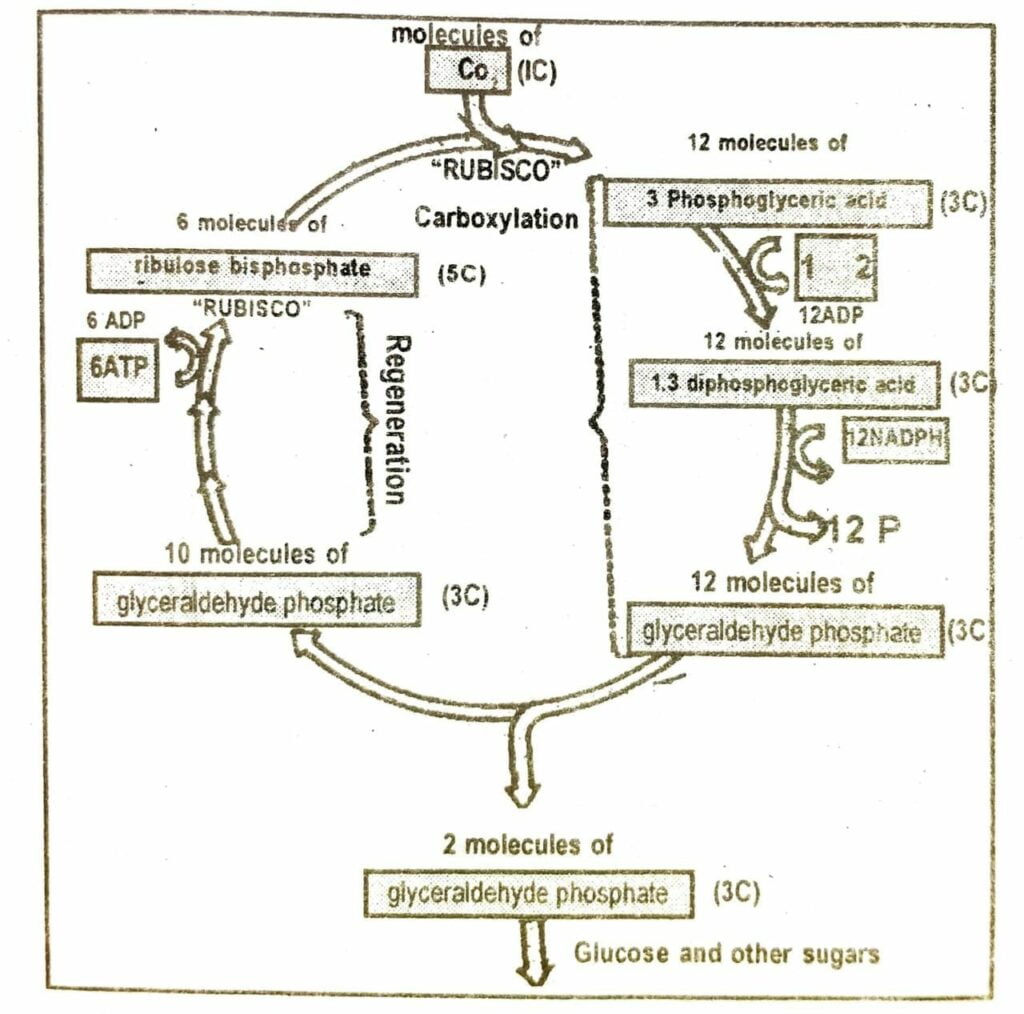
Out of these 12 molecules of PGAId, two are utilised for the conversion of Fructose, i. 6 diphosphate and subsequently to glucose, sucrose, starch etc.
(3) Regeneration of RuDP – The remaining 10 molecules of PGAId are utilised for regeneration of 6 molecules of RuDP in a series of reactions so that the cycle run in cyclic manner without break.
Summery of Calvin cycle are :-
6RuDP+6CO₂ + 12APT + 12NADPH₂ →
6RuDP+C₂H₁₂ O₆+ 12ADP + 12Pi + 12NADP.
Difference between Calvin cycle and Hatch and slack cycle.
Calvin Cycle:
1. The primary acceptor of CO₂ is RuDP.
2. The first stable compound in 3 PGA, which is a three carbon compound.
3. Only one type chloroplasts are involved.
4. 18 ATP are utilised for the synthesis of one sugar molecule.
Hatch and Slack Cycle:
1. The primary acceptor of CO₂ is Phosphoenol pyruvic acid (PEP).
2. The first stable compound is Oxalo acetic acid (OAA) which is a four carbon compound.
3. Two types of chloroplasts are involved.
4. 30 ATP are utilised for the synthesis of one sugar molecule.
Q.5. Describe Hatch and Slack pathway or C₄ Cycle.
Ans :- In Hatch and Slack pathway or C₄ cycle the mesophyll cells as well as bundle sheath cells are involved. It occurs in plants having Kranz type of leaf anatomy.
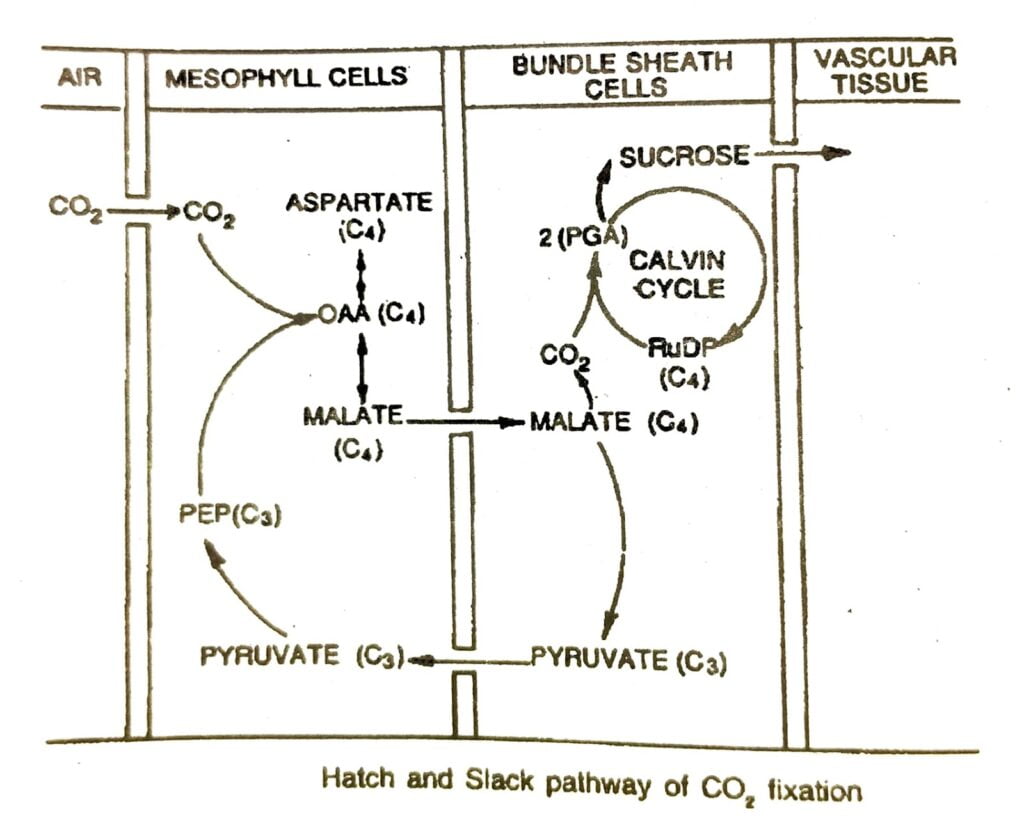
In the Mesophyll cells CO₂ is accepted by Phosphoenol pyruvic acid (PEP) in presence of enzyme PFP Carboxylase. PEP is converted into Oxaloacetic acid (OAA) which is a 4 carbon compound. The OAA is readily converted into Malic acid and Aspartic acid which are interconvertible. Malic acid is then transported into the chloroplasts of bundle sheath where it is converted into pyruvic acid and Co₂. The released Co₂ enters Calvin cycle and is used for the synthesis of sugar.
The Pyruvic acid is transported back to the Chloroplasts of the mesophyll cells where it is reconverted into phosphoenol pyruvic acid utilising ATP.
In Hatch and Latch pathway altogether 30 ATP are utilised. The synthesis of one sugar molecule. 18 ATP are utilised in Calvin cycle and 12 ATP are utilised in conversion of Pyruvic and into PEP.
Q.6. Briefly describe the factors affecting the process of photosynthesis.
Ans :- The factors affecting the process of photosynthesis are:
i) Light: The intensity, quality and duration of light affect photosynthetic rate. 1-29% of total light is utilised by plants. Within this limit the increase in intensity of light increases photosynthetic rate. Shade plants require low to moderate light. Light not only activates chlorophyll but it also regulate the opening and closing of stomata.
ii) Temperature: Usually the rate of photosynthesis increases with increases in the temperature upto 40⁰C. C₄ plants respond to higher temperature and show higher rate of photosynthesis while C₃ plants have a much lower temperature requirement.
iii) Carbon-dioxide concentration: The concentration of Co₂ is very low in the atmosphere ie it is between 0.03-0.04%. Increase in concentration up to 0.05% can cause an increase in Co₂ fixation rates, beyond this the level can became damaging.
At high light intensities, bath C₃ and C₄ plants show an increase in the rate of photosynthesis.
iv) Water: Under normal condition, water plays no significant role as only 1% water observed is used in photosynthesis. However, when this minimum amount of water is not available then photosynthesis may not take place.

Hi, I’m Dev Kirtonia, Founder & CEO of Dev Library. A website that provides all SCERT, NCERT 3 to 12, and BA, B.com, B.Sc, and Computer Science with Post Graduate Notes & Suggestions, Novel, eBooks, Biography, Quotes, Study Materials, and more.




